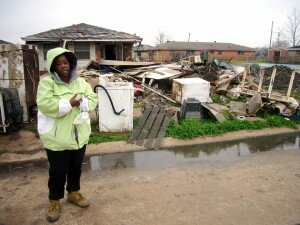Posts Tagged ‘triple bottom line’
10 steps to employee engagement in sustainability
Today’s guest post is by Eric Brody, a member of the R.Bruer Sustainable Branding Collaborative. Eric is founder and principal of Shift Advantage, a sustainability consultancy in Portland, Ore. He was previously the sustainability business integration manager for Nike and sustainability manager for Nau, a technical outdoor and urban clothing company recognized for its innovative sustainability practices.

Much has been written about how to involve employees in more environmentally friendly office practices, such as reducing paper consumption, carpooling, turning off computers at night, recycling, and composting food scraps. As important as these and many other behaviors are to greening an office, they only take a business so far down the sustainability path.
If your vision is to build a sustainable business operating from a triple-bottom-line (people, planet, profit) philosophy, then sustainability is core to your business strategy. Your challenge involves more than green office practices. It means creating a business whose success is measured by its social, environmental and financial contributions.
Executives can only achieve their vision of a sustainable business by engaging and involving their work force. They need everyone in their companies on board. The question is how to engage all employees in the practice of strategic sustainability.
Fully engaging employees in strategic sustainability
At the risk of over-simplifying what can be a complex undertaking, I’ll offer a 10-step approach to employee engagement:
- Develop a strategic business plan that clearly articulates your social, environmental and financial objectives and strategies over a period of up to five years. I’ve worked with companies that set very aggressive stretch goals such as zero waste or zero carbon footprint by a certain date to ones that set more pragmatic goals such as reducing waste or the carbon footprint by a certain percentage.
-
Share your business plan with each group or department. Ask each group to review their individual plan and goals with the intention of incorporating or expanding the practice of sustainability into their metrics of success. Each unit may be different: Purchasing may adopt social and environmental performance requirements in their procurement contracts with suppliers. Product development and design may adopt design for environment (DfE) techniques into their processes.
 This type of thinking leads to innovations such as creating products that are lighter, repairable, utilize rechargeable energy sources, use energy more efficiently, or require low impact cleaning by the user. Accounting may investigate new models for measuring and tracking social and environmental impact, in addition to financial performance such as the greenhouse gases associated with business travel.
This type of thinking leads to innovations such as creating products that are lighter, repairable, utilize rechargeable energy sources, use energy more efficiently, or require low impact cleaning by the user. Accounting may investigate new models for measuring and tracking social and environmental impact, in addition to financial performance such as the greenhouse gases associated with business travel.
- Set department goals, both short term and long term (quarter, annual, three-to-five year). Companies may choose to make their environmental and social goals based on company totals or on a per unit or per dollar basis.
- For each job function and individual, determine responsibilities and expectations related to achieving the department’s and the overall business’ sustainability goals. As much as possible, make this an exercise of co-creation between a manager and an employee. You want every employee feeling enthused and empowered to make a difference. You also want to let employees know their contributions to sustainability will be a factor in their annual performance reviews (see Step 7). Set goals that are SMART: specific, measurable, attainable, realistic, timely.
- Provide training for each employee to grow competency and skills related to improving their individual contributions to your triple bottom line. Where possible, develop or seek sustainability training that is domain-specific, e.g., marketing, product development, manufacturing, customer service, human resources. This can include sending your employees to conferences or workshops or participating in industry or cross-industry collaborative working groups that are addressing specific issues such as water, logistics, fair labor and energy efficiency.
- Check-in regularly (weekly, monthly, quarterly) to monitor progress on the sustainability front, such as in manager/employee one-on-ones or staff meetings. This enables mid-course corrections and prevents year-end disappointments in group or individual performance.
- During annual reviews, evaluate each employee’s performance related to his or her individual and group sustainability goals. This reinforces the importance of achieving these to the company.
- After their performance reviews, ask employees to produce new or revised 12-month SMART goals to help their departments and the company achieve sustainability objectives. Be sure to share with employees any changes to business or department plans so they can align their individual efforts accordingly.
- Throughout the year, acknowledge and celebrate individual and group sustainability achievements across the company. Consider contests that motivate individuals and groups to out-perform each other and help make the sustainability journey about having fun and making a difference.
- Work with each department to engage their stakeholders and report publicly the achievements and challenges. This may include summits with your supply chain, reporting achievements and challenges to the public through corporate responsibility reports or websites or engaging customers through customer surveys and communications. The Global Reporting Initiative (GRI) provides a thorough framework for corporate responsibility reporting.
We have seen great success with companies that take these steps to fully engage their employees. This strategic approach moves sustainability from theory to practice within a company. The more engaged employees are, the more they will help your business innovate, achieve industry leadership, reduce costs and increase market share.
Imagining the ‘Sustainable Communicator’
Based on the scale of green marketing we see across all media today, you’d think the practice of sustainability is spreading like wildfire throughout business. And you’d be wrong.
I was reminded of the green vs. sustainability disparity as I was preparing a talk I gave last week to the Communicators Conference in Portland, Ore. In the talk I outlined a vision for what I called the “Sustainable Communicator.”  If this vision came to pass today, I believe we’d see an immediate ratcheting back on the practice of green marketing and a spike in the practice of sustainability.
If this vision came to pass today, I believe we’d see an immediate ratcheting back on the practice of green marketing and a spike in the practice of sustainability.
Let me explain.
First, consider these two studies from 2009:
- In its study entitled “The Road Not Yet Taken,” the Sustainable Enterprise Institute reviewed the public information disclosed by companies in the Russell 1000 Index and concluded: “evidence of any broad spectrum adoption of sustainable business practices is not to be found.”
- The Boston Consulting Group and MIT Sloan Management Review surveyed 2,000 business leaders worldwide as part of their study called “The Business of Sustainability.” The authors reported “a material gap between intent and action at most companies” they examined.
Which begs the question, if business is so slow to embrace sustainability, how can there be so much green marketing? I believe the explanation is this: Sustainability and green are two different concepts. They are not interchangeable. As The Natural Step Network tells us in their workshops, green is focused on details, tactics, environment and “less bad.” Sustainability is focused on whole systems, strategy, triple bottom line (not just the environment) and aligning with nature’s cyclical processes.
Retire green marketing
If I had my way, I’d retire green marketing, as I argued in a previous post. Green marketing in business is first and foremost product marketing. And as we know, you don’t have to be a sustainable business to produce a “green” product.
As the studies above indicate, businesses that adhere to the principles of sustainability and operate from a triple-bottom-line (people, planet, profit) philosophy are uncommon. That means the majority of “green” products are produced, marketed and/or sold by companies that fall far short of the sustainability ideal.
I’m not opposed to green products. We need more of them. But relying on otherwise brown companies to produce green products is at best a “less bad” situation (and clearly the primary reason for greenwashing). If we are to solve the pressing social and environmental issues of our time — clean water, peak oil, over-consumption, income inequity, population growth, climate change — we need businesses fully on board with sustainability.
Fusing brand, culture, sustainability
And here’s where the Sustainable Communicator comes in. This mythical professional fuses the practices of branding, culture change and sustainability into something completely new.
The Sustainable Communicator is a result of a fundamental shift in focus and responsibility:
- from marketing green products to building sustainable businesses
- from creating brand image to living your brand
- from specialist in communications to leader in sustainability, organizational development and branding
Yes, the Sustainable Communicator remains an expert in communications. That goes without saying. She is also a leader in sustainability, triple-bottom-line management, culture change and collaboration.
I admit this is a tall order and unrealistic in the short term. But if business is going to be truly sustainable, it needs new leaders to emerge in all disciplines, including communications. Because we know there’s a significant gap between what business intends to do and what it’s actually doing in the areas of social and environmental responsibility.
The need to close this gap is the impetus behind my firm’s recent formation of the Sustainable Branding Collaborative and 4D Branding process.
Closing the intent vs. action gap
Communications professionals have a major role to play here. We can’t continue green marketing and pretend the gap doesn’t exist. The buck stops with us, as storytellers, to only share what we know to be true and to accurately reflect where our companies are along the path of sustainability.
But storytelling alone is too passive, too removed from the ultimate need of businesses to move farther and faster toward become truly sustainable. The Sustainable Communicator is more than a storyteller. She’s a hands-on leader in transforming business. And it’s in that experience she recognizes green marketing is a thing of the past.
Don’t wait on triple-bottom-line accounting standard
Brian Setzler is a staunch advocate of triple-bottom-line (TBL) business practices. He’s also a realistic CPA in Portland, Ore. who knows we’re years away from internationally recognized and adopted rules for TBL accounting.
Brian and I have been each other’s client: I helped him define the brand of his new firm TriLibrium and his firm did my taxes. I figured he’d be the perfect person to give me a read on where TBL stands in the accounting profession. Not surprisingly, there’s much work to be done, starting with general awareness.
“Half or more of accountants today don’t even know what ‘triple bottom line’ means,” Brian says. Having recently completed an MBA in sustainability, Brian sees business schools increasingly doing their parts to introduce and teach the concept. But a good understanding of TBL principles among professional accountants is uncommon. Even more rare are accountants such as Brian who make TBL practices the cornerstone of their business.
Brian believes it could be 15-20 years or more before governing bodies in accounting expand rules to include environmental and social performance reporting, in addition to financial. He points to the years it took the U.S. Financial Accounting Services Board (FASB) and SEC to agree on moving from Generally Accepted Accounting Practices (GAAP) to International Financial Reporting Standards (IFRS). The official move to IFRS in the U.S. is still five years off. The point being, the wheels of accounting governance move slowly. Getting to a TBL version of IFRS is years down the road.
Taking matters into your own hands
That doesn’t mean individual businesses shouldn’t take matters into their own hands when it comes to accounting for their environmental footprint and social impact. There are plenty of sustainability consultants and tools that can help.
Brian and his firm aren’t waiting for the world to converge on international TBL standards. “We hold a very high bar for ourselves.” Despite being a small business, TriLibrium is making a significant investment in producing a sustainability report based on the Global Reporting Initiative guidelines. “It’s one of the things that separates the real deal from the wannabes in sustainability,” he says.
For Brian, adopting the triple bottom line is akin to the move to PC-based business systems 25 years ago. “It’s just the way business is going. It’s the future of business.” And as more companies such as Wal-Mart push their sustainability standards down into their supply chain, it will no longer be enough to say you’re green. “In the future it will be, ‘Prove it. Show me, don’t just tell me.’ If you’re not doing this today, you’re missing the boat.”
Imperfect triple bottom line far better than alternative
Sustainable Industries magazine asks the question: “Is triple-bottom-line accounting really possible?” From their reporting, the answer appears to be not yet. The article quotes a San Francisco attorney:
“The notion of triple-bottom-line accounting assumes or incorporates the idea in the nomenclature that there’s a standard…The reality is, there isn’t.”
He is referring to the absence of a unit of measure that works across each of the three dimensions of economic, social and environmental accountability. Right now, environmental or social investments or decisions tend to be evaluated by the one measurement businesspeople best understand: financial ROI. In other words, the one bottom line that has always been with us. As a result, decisions that would appear to benefit the environment or community, but hurt profitability, are too easily dismissed. As in, we can’t afford to do the right thing.
I believe we are making the notion of the triple bottom line (TBL) too complex. And that’s preventing businesses from embracing its simple principle, which is to strike a balance among the sometimes competing interests of making money, protecting the environment and supporting our communities.
As Sustainable Industries observes, financial accounting over the course of many years has “established standardized, legal frameworks for what to measure, how to measure it, how to report it and how to interpret it.” The environmental and social components of the TBL are far from reaching that status. And yet, businesses can’t let that stop them from at least trying to find balance in their decision making, even when social or environmental outcomes may be difficult to measure and value.
Consider today’s financial crisis. Fingers are pointing in every direction, and there is indeed plenty of blame to go around: greedy investors, lenders and home buyers, lax regulators, gutless politicians, to name a few. But I can’t imagine we’d be in this mess if business was guided by the triple bottom line, even as it’s loosely understood today:
- Would mortgage lenders concerned for their customers and communities ever have offered $400,000 loans to people with no proof of income or assets?
- Would Wall St. investors ever have purchased these so-called subprime loans and packaged them for sale as low-risk securities if they were thinking of more than just maximizing profit?
- Would government ever have let investors acquire and trade trillions of dollars of these securities without public scrutiny if they actually felt obligated to protect the individual taxpayer?
We’re seeing now, in the prospect of a $700 billion taxpayer bailout, what this country’s obsession with making money has cost us. The financial bottom line alone is like the presidency without Congress and the Supreme Court: There are no checks and balances. The only brakes on economic excesses are wrenching recessions, if not depressions, after which we’re back to business as usual. How quickly did we move from the dotcom bubble to the housing bubble?
To return to the question the magazine asked: Maybe triple-bottom-line accounting isn’t possible. But there’s no excuse any longer for pretending our unfettered pursuit of profit is the answer.




 employee in small groups and made it abundantly clear what would be expected of them going forward.
employee in small groups and made it abundantly clear what would be expected of them going forward.